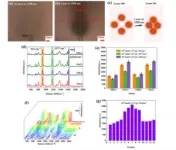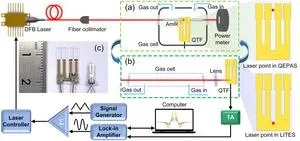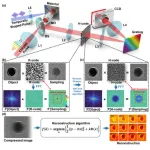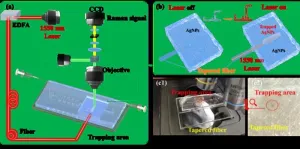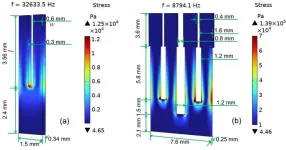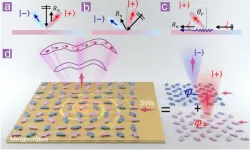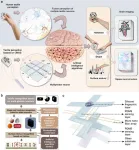A new publication from Opto-Electronic Advances; DOI 10.29026/oea.2025.240193 , discusses a novel approach towards robust construction of physical colors on lithium niobate crystal.
Color has a profound impact on the way humans observe, perceive and understand the world. It is like a silent language, subtly shaping our perception and response to the surrounding environment. From the first ray of sunshine in the morning to the twinkling stars in the night sky, colors are everywhere. They are not only a visual stimulus, but also a power that can touch the depths of the soul. Therefore, for thousands of years humans have struggled to reproduce the colors they observe using various methods. As early as around 3000 BC, people had mastered the technology of extracting natural dyes from plants, animals and minerals. With the continuous development of science and technology, metal oxidation, coating and other coloring methods have also entered people's field of vision. In recent decades, special physical colors such as artificial structure colors have become a new focus due to their unique advantages including non-toxicity, sustainability and durability. In addition to decoration, it can also be used in the fields of solar energy, anti-counterfeiting and information encryption. The generation of structure color is attributed to the localized surface plasmon resonance (LSPR) effect, that is, the sub-wavelength structure with specific period and shape can cause electrons to resonate with electromagnetic waves with specific wavelength or band, thereby forming strong absorption or transmission peaks, and forming the macroscopic colors we see. The preparation of such special structures usually relies on micro-nano fabrication methods such as photolithography and wet etching with high economic and time cost. Or the use of femtosecond laser can achieve surface coloring of several materials such as metal and doped glass. However, the interaction mechanism between femtosecond laser and the surface of wide bandgap materials such as semiconductor, crystal and ceramic is complex, thus, the shape and period of the formed artificial structures are often difficult to control. Therefore, low-cost artificial structure coloring on the surface of such materials is still a technical embarrassment.
But, if one considers it from a wider perspective, in the field of material science, the synthesis and use of metal nanoparticles are very mature and extensive. For visible light, these nanoparticles naturally possess sub-wavelength period and are good carriers for the LSPR effect. If metal nanoparticles can be embedded into solid samples and their sizes can be precisely controlled, they can effectively induce artificial structure colors on the solid surfaces. Therefore, in this article, we demonstrate the use of gold ion implantation combined with laser direct writing technology to achieve stable physical coloring on the surface of lithium niobate single crystal. Ion implantation is a mature non-equilibrium process that can produce a variety of metastable solid solutions and has been widely used in modifying the surface characteristics of various materials. In this work, when the dose of implanted gold ions exceeds their solid solubility in the lithium niobate crystal, aggregation occurs and these ions will precipitate into gold nanoparticles. At this time, continuous visible laser irradiation with specific resonant wavelength can heat up the metal nanoparticles and cause further aggregation. In this way, the sizes of these nanoparticles can be precisely controlled. Using typical laser direct writing procedure, multiple colorings on the surface of lithium niobate crystals can be achieved. The colors formed by this method, the color basis - metal nanoparticles, can be protected inside the bulk material from corrosion, oxidation and other effects from the external environment, so it presents considerable stability. Moreover, ion implantation technology and continuous laser direct writing technology have both been widely used, and they are more economical than the traditional micro-nano manufacturing processes. The effects of ion implantation and laser direct writing processes on the lattice structure of lithium niobate crystal are also characterized and analyzed in this paper.
Keywords: Au ion implantation / laser direct writing / lithium niobate crystal / surface color
# # # # # #
The research group of Associate Professor Hongliang Liu from the Institute of Modern Optics of Nankai University has successively achieved breakthrough research results in multiple research directions. Their research fields include femtosecond laser micromachining, ion beam modification, laser spectrum detection and imaging, micro-nano optical functional devices. In recent years, teachers and graduate students in this group have published more than 50 articles in high-level scientific journals, including Acta Materialia, Nanophotonics, Journal of Lightwave Technology, Optics Letters, Applied Physical Letters, and Applied Surface Science. Several articles are selected as Editor's Pick, Supplementary Cover, Back Cover article. They have currently obtained multiple related patent authorizations. In addition, part of the work is featured in the famous journal Laser Focus World.
# # # # # #
Opto-Electronic Advances (OEA) is a rapidly growing high-impact, open access, peer reviewed monthly SCI journal with an impact factor of 15.3 (Journal Citation Reports for IF2023). Since its launch in March 2018, OEA has been indexed in SCI, EI, DOAJ, Scopus, CA and ICI databases over the time, and expanded its Editorial Board to 34 members from 17 countries.
# # # # # #
More information: http://www.oejournal.org/oea
Editorial Board: http://www.oejournal.org/oea/editorialboard/list
All issues available in the online archive (http://www.oejournal.org/oea/archive).
Submissions to OEA may be made using ScholarOne (https://mc03.manuscriptcentral.com/oea).
ISSN: 2096-4579
CN: 51-1781/TN
Contact Us: oea@ioe.ac.cn
Twitter: @OptoElectronAdv (https://twitter.com/OptoElectronAdv?lang=en)
WeChat: OE_Journal
# # # # # #
Yang QX, Yu MH, Chen ZX et al. A novel approach towards robust construction of physical colors on lithium niobate crystal. Opto-Electron Adv 8, 240193 (2025). doi: 10.29026/oea.2025.240193
END

